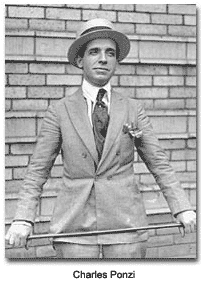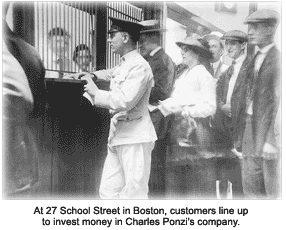General Interest, 1882-1949
Carlo
Ponzi, famously known as Charles Ponzi, was a criminal with a cunning
mind and a slick way with speech. Unfortunately for him, his talents
did not keep him out of jail. His name would become permanently
associated with a type of investment fraud in which handsome returns
are promised from made-up sources and early investors are supposedly
compensated with money raised from later ones. 
Early on Charles
Ponzi was born in Parma, Italy, in 1882. He grew up there and then
moved to the United States in November 1903, when he was 21 years old.
Ponzi saw many opportunities to pursue, but could not find his "nitch."
Over the next 14 years he bounced from city to city, working as a
waiter, dishwasher, clerk, and translator of Italian. Then, around 1917
he settled down in Boston where he took a typing job and answered
foreign mail. Ponzi worked legitimately for two years until one
day he discovered a way to make himself and investors rich. From that
day on, Charles pursued for "the gravy train" — beginning a life of
lies and scandals. During that time he married a woman named Rose, who
stayed by his side through thick and thin. Oh, how the money started
coming in. Unfortunately for him, the scandals caught up with him, then
his became a life on the run, of trying to avoid jail. Ponzi participated in scams from Providence, Rhode Island,
to Montreal, Quebec, where he wound up in prison for his efforts. But
Ponzi's ambition was as big as his adopted province. He thought he was
destined to be rich. The Security Exchange Company On
December 26, 1919, Ponzi established a firm called The Security
Exchange Company. He boasted a return of 50-percent interest in 90
days, and the world wanted in on it. Ponzi’s great idea created
an instant "feeding frenzy," and within a few short months, lines
formed outside his School Street office door. Thousands of people
purchased so-called Ponzi promissory notes at values from $10 to
$50,000. The average investment was estimated to be around $325. Ponzi
and his staff brought in a million dollars per week. Desk drawers, file
cabinets, closet space, and virtually any extra storage area were
filled with investors' hard-earned cash. The scheme Ponzi,
who swindled the gullible out of millions by 1920, invented what came
to be known as a Ponzi Scheme, a scam in which early investors are paid
with money from new investors (similar to today's "pyramid scheme").
The con game had been around for years, perhaps centuries. But Ponzi
played it on such a grand scale, with such flair, and in full view of
the media and the world, that he earned a prominent place in criminal
history. Some historians have described Ponzi as "a celebrity." 
The
most notorious "Ponzi Scheme" took place when he began to trade postal
reply coupons in 1919. Plenty of Americans in other countries could
include such a coupon in a letter, to be redeemed at the post office
for enough money to send a reply. Ponzi used his Securities Exchange
Company as a front to trade the coupons and make a 200-percent profit.
That was not how he continued his business, however. He eventually
moved to Florida to pursue new schemes. After authorities
caught up with him in Florida, he fled to Texas, where he was
apprehended and sent to jail. Upon his release, Ponzi's wife divorced
him and he was eventually deported to Italy. At the age of 52, he had
to start over again. Later years Ponzi became an
English translator while in Rome. Benito Mussolini offered him a
position with Italy’s new airline and he served as the Rio de Janeiro
branch manager from 1939-1942. Ponzi discovered that several
airline officials were using the carrier to smuggle currency, and Ponzi
wanted his share. When the smugglers laughed at him, he tipped off
Brazilian authorities — leading to the arrest of three top airline
officials. World War II brought about the airline’s failure, and Ponzi soon found himself without a job again. Charles
stayed in Rio de Janeiro with hopes of "finding his way" financially.
After trying to run a Rio lodge (which failed), Ponzi found himself
either collecting Brazil unemployment insurance or giving English
lessons — a far cry from the millionaire that he had become just a
decade earlier. Carlo "Charles" Ponzi died in the charity ward of a Rio de Janeiro hospital in 1949, at the age of 67. "The last picture of Ponzi, taken in the hospital, showed him with a big smile on his face." - Boston Globe
Off-site search results for "Charles Ponzi"... Charles Ponzi
...
on his face." There have been many "Ponzi's" both before and since the
time that Charles Ponzi conned people out of large sums of money. He
and others took advantage of two well-known human weaknesses; laziness
and greed. AdvertiseCharles Ponzi conned people out of large sums of
money. He and others took advantage of two well-known human weaknesses;
laziness and greed. Advertise a scheme ...
http://www.goldhaven.com/scam_page/Ponzi.htm
Charles K. Ponzi Website
Need browser which supports frames to see this page ...
http://www.mark-knutson.com/
The Ponzi Scheme
...
and the depositors. He also planned to reopen his company under a
new name, the Charles Ponzi Company, whose main purpose was to invest
in major industries around the world. (Apparently, no one ever
told Ponzi that the key to any sCharles Ponzi Company, whose main
purpose was to invest in major industries around the world.
(Apparently, no one ever told Ponzi that the key to any successful ...
http://home.nycap.rr.com/useless/ponzi/
Sponsors of U-S-History.com:
Sponsor this site
|



